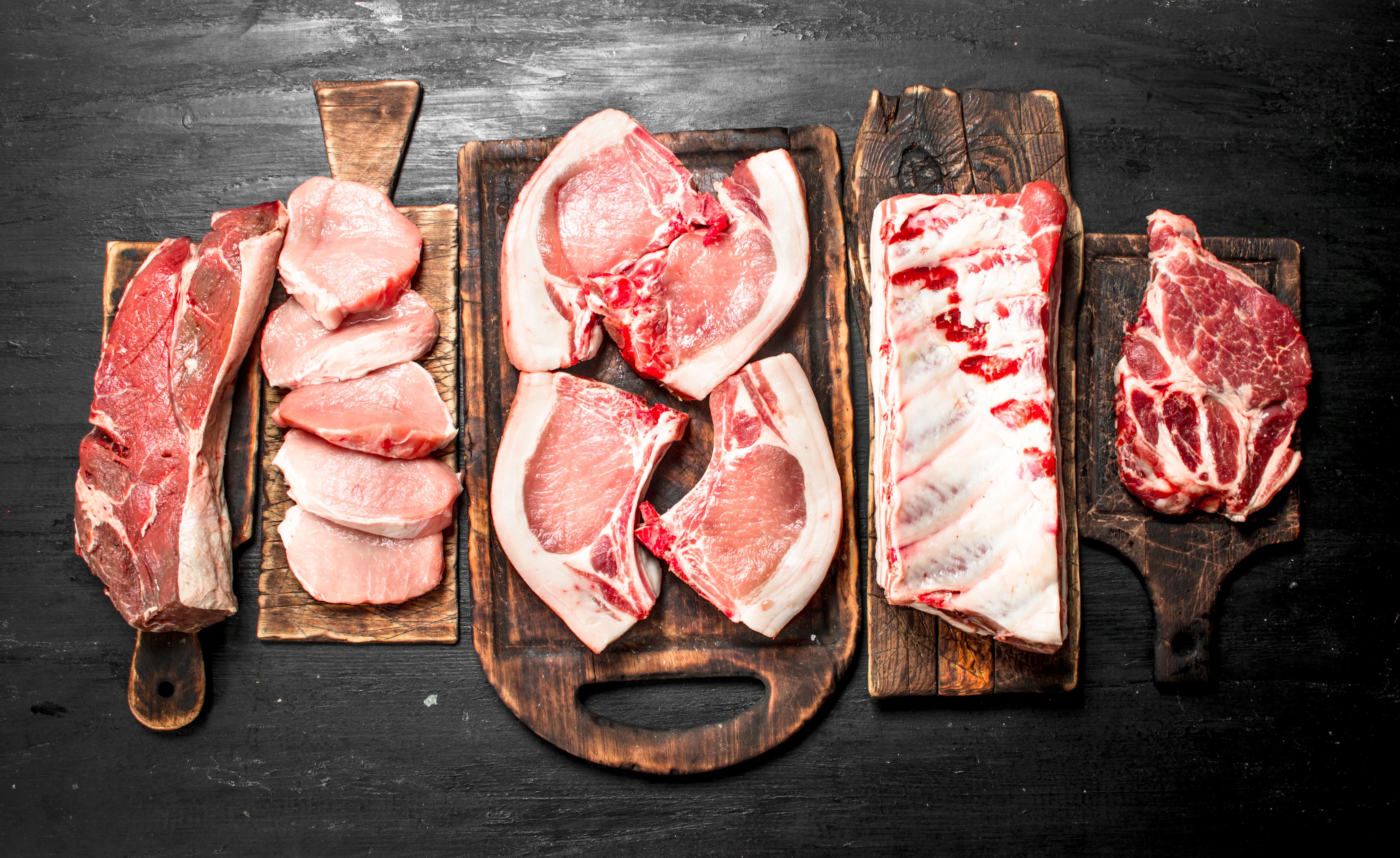New Technology Predicts Nutritional Stability of Frozen Pork
Jiangxi Agricultural University researchers use AI and vis-NIRS to predict meat quality and freezing duration with high accuracy.
Researchers from Jiangxi Agricultural University recently experimented to see if their new method, which uses spectral imaging and machine learning (ML) techniques, can improve the long-term preservation of pork. The study’s findings, which were published in Food Chemistry, provide additional insights into how pork and other frozen meats can be preserved (1). Their insights helped show how frozen storage, which is a common practice globally for meat production, affects the quality of the meat over time (1).
Different types of raw pork meat and beef. | Image Credit: © Artem Shadrin - stock.adobe.com

Pork is a meat product that comes from hogs and pigs, and it is a popular meat in both the United States and around the world. According to the U.S. Department of Agriculture, the United States is the third-largest producer and consumer of pork (2). The United States is also the world’s second-largest exporter of pork muscle meats (2). Currently, hog operations in the United States are concentrated in eastern North Carolina and the Midwest (2). As part of the production process, pork, once it is ready to be shipped around the United States and the world, is frozen to preserve it for the market.
Because of this, those in the food industry are concerned with frozen preservation strategies and how these can better preserve pork. There are both economic and health concerns at play with frozen pork reserves, which makes it important to monitor the nutritional and physicochemical changes of pork during extended storage (1). The research team sought to investigate this issue in this study.
Over 12 months, the research team conducted a frozen storage experiment at –20 °C, using longissimus muscle samples from 50 pigs (1). Over the course of the year, the researchers monitored 62 distinct meat quality components grouped into seven categories, including thawing loss, myoglobin levels, fatty acids, amino acid profiles, and various indicators of spoilage (1).
Under proper freezing conditions, the researchers determined that pork could maintain its quality for up to two years, with clear signs of degradation emerging after the four-year mark (1). To determine this number, the researchers used a time-series forecasting tool called Prophet, and this allowed the researchers to analyze the trends and stability of meat composition across various time points (1).
One of the important aspects of this study was what the team noticed with the phenotypic correlations and clustering anomalies. As an example, the fatty acid arachidonic acid (C20:4n6) and the amino acid methionine (Met) showed consistent deviations from their respective group clusters (1). These were outliers. What they suggested was that the complex biochemical interactions occurring during long-term storage merit further investigation in future studies.
To supplement their chemical and physical assessments, the researchers incorporated advanced spectroscopic analysis using visible and near-infrared (vis–NIR) spectroscopy. They collected spectral data with two different scanning devices and tested the predictive power of nine ML algorithms (1). Among these, the AdaBoost model using transmission spectra from the SpecimIQ device achieved the highest classification accuracy at 85.8% (1).
By developing a reliable classification model for frozen storage time, the researchers demonstrated the utility of using vis-NIR spectroscopy with ML to monitor meat processing and storage management scenarios. One of the most important ongoing challenges in the food industry is how to combat food waste and insecurity. Because the method presented here can be used to ensure meat quality, the researchers discussed how their findings could inform policy decisions related to national food reserves and provide meat producers and processors with a scalable solution for real-time quality control (1).
Future studies will most likely look at using ML and spectral imaging in tandem to examine other frozen meat products, such as ground beef and turkey. By offering a robust framework for evaluating meat quality over time, this research not only improves the operational efficiency of frozen pork reserves but it also contributes to broader efforts in food safety assurance and sustainability (1).
References
- Tang, X.; Xiao, H.; Luo, T.; et al. Tracking Nutritional and Quality Changes in Frozen Pork: A 12-Month Study Using 7 Categories of Meat Parameters and Vis-NIR Spectroscopy. Food Chem. 2025, 481, 144003. DOI: 10.1016/j.foodchem.2025.144003
- U.S. Department of Agriculture, Hogs & Pork. USDA.gov. Available at: https://www.ers.usda.gov/topics/animal-products/hogs-pork (accessed 2025-04-21).
Smarter Sensors, Cleaner Earth Using AI and IoT for Pollution Monitoring
April 22nd 2025A global research team has detailed how smart sensors, artificial intelligence (AI), machine learning, and Internet of Things (IoT) technologies are transforming the detection and management of environmental pollutants. Their comprehensive review highlights how spectroscopy and sensor networks are now key tools in real-time pollution tracking.
Karl Norris: A Pioneer in Optical Measurements and Near-Infrared Spectroscopy, Part II
April 21st 2025In this two-part "Icons of Spectroscopy" column, executive editor Jerome Workman Jr. details how Karl H. Norris has impacted the analysis of food, agricultural products, and pharmaceuticals over six decades. His pioneering work in optical analysis methods including his development and refinement of near-infrared spectroscopy, has transformed analysis technology. In this Part II article of a two-part series, we summarize Norris’ foundational publications in NIR, his patents, achievements, and legacy.
New Raman Spectroscopy Method Enhances Real-Time Monitoring Across Fermentation Processes
April 15th 2025Researchers at Delft University of Technology have developed a novel method using single compound spectra to enhance the transferability and accuracy of Raman spectroscopy models for real-time fermentation monitoring.
Karl Norris: A Pioneer in Optical Measurements and Near-Infrared Spectroscopy, Part I
April 15th 2025In this "Icons of Spectroscopy" column, executive editor Jerome Workman Jr. details how Karl H. Norris has impacted the analysis of food, agricultural products, and pharmaceuticals over six decades. His pioneering work in optical analysis methods including his development and refinement of near-infrared (NIR) spectroscopy has transformed analysis technology. This Part I article of a two-part series introduces Norris’ contributions to NIR.